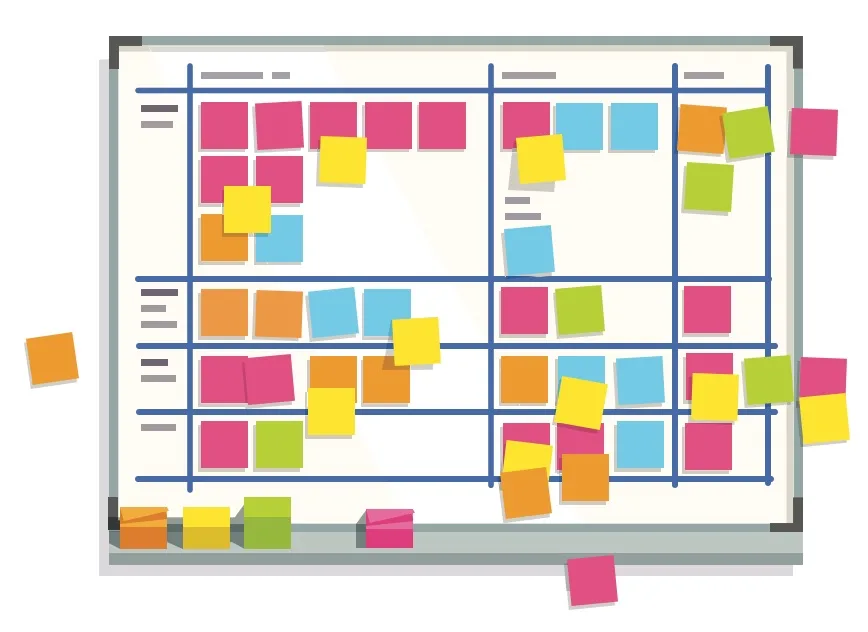We’re all familiar with the Goldilocks story, right? As she walked through the house she came upon in the forest, she kept trying things out. There was always a version that was too much/big/hot and a version that was too little/small/cold. And then there was her perfect fit, right in the middle. Workshops are like that, too.
Hear me out.
When you’re starting on a big new digital project, be it a website, a new immersive retail experience, or an entire technology system overhaul, there is a lot to discuss. The discussion and decisions required for these large projects are big ones, and impact a lot of people.
You don’t want to start with no roadmap, yet there isn’t always a clear sightline in the early part of the project. On the other end of the spectrum, RFPs or project proposals that require everything be outlined (deliverables, process, etc.) are rarely accurate because it’s too hard to guess those details at this stage of the game, so those can be a lot of wasted effort. So how do you find just the right distance between no plan and too much plan? Workshops. AKA the Goldilocks solution.
Workshops give the client team a chance to collaboratively work through a vision, roadmap, and objectives. It gets you 15% closer to clarity, which makes estimating, scoping, and iterative development so much easier.
Breaking it down: What are workshops?
Workshops include many different exercises and can provide a lot of different outcomes because they are easily customizable. Whatever the problem or outcome you’re looking for, a workshop can be tailored to prompt new thinking or action around that. The general ingredients stay the same, though: user-centered focus, interactive exchanges, and collaborative thinking. Below are a few examples of workshops we’ve done. As you can see, their goals and structures vary.
Example: Strategic alignment
We worked with a service-based group that wanted to tighten up their marketing and sales model. They weren’t sure if they needed to simply change the language on their website or if they needed a brand redo. Moreover, they were looking at how to best align the leadership team, the sales team, and the marketing team around a common plan.
We completed a strategy canvas workshop that provided them with a snapshot of their current marketing space. This snapshot was the jumping off point for an aligned conversation around how to best serve clients and their business without over-expanding or being too confined.
Example: Generate new ideas
One of our B2C clients sells products in a crowded market. Their customers typically buy the brand they know because it’s difficult to learn about other brands on the spot at the store. They came to us seeking ideas of how to show up differently in that retail experience that took advantage of customers’ in-store attention.
We did a 2-day innovation strategy workshop with them to discover opportunities for technology to complement and enhance the purchasing moment experience. We explored the way voice or VR might help potential customers see the brand in a new way. We explored how to match customer problems with specific product solutions without the customer having to do much work. In the end, they got a handful of energizing ideas and a reframed problem that helped their team decide on next steps.
Example: Shift approach to doing business
Over the course of a year, we worked with a subset of internal teams from a large company, as well agency and vendor partners, to shift the enterprise from a siloed project-delivery culture to a global, agile product delivery and lifecycle culture.
To give everyone a hands-on experience with customer-centered product delivery, we treated the workshop itself as a product. We held a four-day workshop with the global team to build a sense of community across disparate regions, to increase their collective knowledge of the vision and goals, and immerse everyone in a new way of working together. In the end, our survey revealed that each participant felt a robust foundation was built to help them be successful in implementing the digital transformation.
And now, why workshops: What is unique to these experiences?
Internal alignment
Often, clients write RFPs to kick off their project. Yet, the thing about RFPs is that they can make it look like there’s internal alignment, but that’s not always the case. The internal team may see eye-to-eye somewhat, but when we get into the real work, we find that there are far more competing objectives than most people expected.
Working together on vision and alignment with key stakeholders, all the same room, clarifies things quickly. It clarifies if there are gaps or misalignments, it clarifies if a vision isn’t serving everyone’s needs, and it can clarify where the team is on the same page. This information is invaluable at the beginning of a project. It means as a team we can adjust before we start spending money on designing and building.
New thinking
One of the primary drivers of “digital transformation” and top-down demands for innovation is the desire for employees to think differently about business. Companies needs more from staff as their industries and customers are demanding more. This requires adaptability, one thing humans are usually really bad at.
Workshops can be a perfect setting for teaching (by example) new ways to think about business. They can help transform the way people see and respond to changes and opportunities in the workplace.
Collaborative discussions
There is a big difference between collaboration and input. Often, stakeholders give input before or throughout the project, maybe in the form of reviewing an RFP or pitch deck. But getting people in the room talking and thinking and doing things together (i.e. collaboration) results in something entirely unique from the outcomes you get when someone signs off on a document.
Unexpected innovations
Yep, that frequently-talked-about-but-rarely-witnessed phenomena: innovation. It’s hard to come by because there is a lot of pressure to do it and a lot of talk about how to do it. Yet, maybe it’s not that hard: the energy and exchanges that happen within a workshop setting are often breeding grounds for real advancements in ideas and solutions.
Innovation doesn’t need to happen in an expensive lab, it needs to happen in a space that allows for all ideas, and for failure, and for feedback. One workshop probably won’t accomplish all that, but the spirit of workshops lay the foundation for it.
A partial roadmap
One of the most beneficial aspects of workshops is what they reveal about your problem and allow you to start to see the beginnings of your solution.
Workshops help when you have a huge project looming. They also help when you want to incrementally improve a singular aspect of your business. Bringing people together and working through a vision or problem in-the-moment is the true value workshops offer. The process is the outcome.




